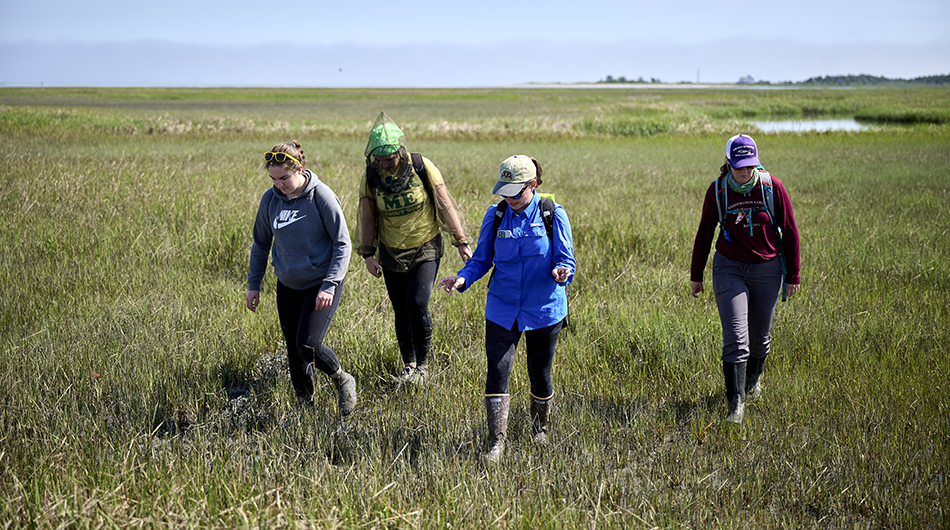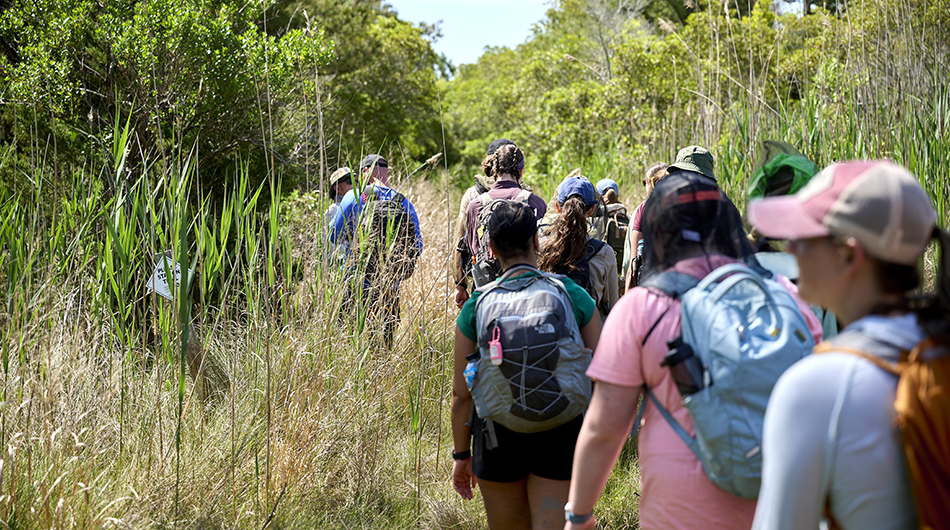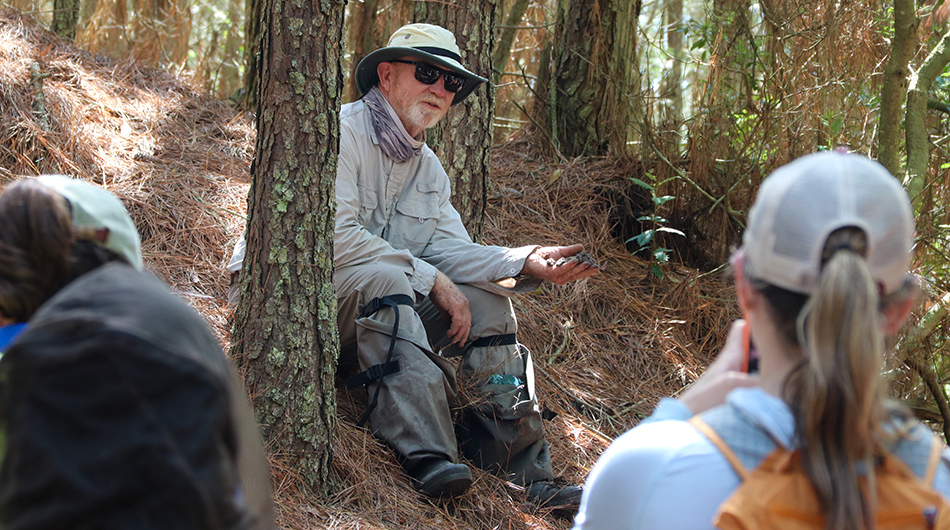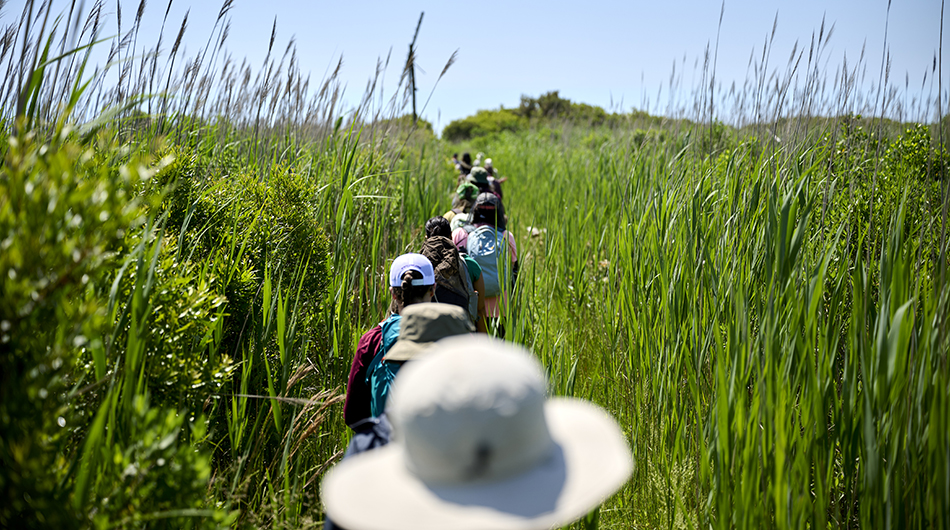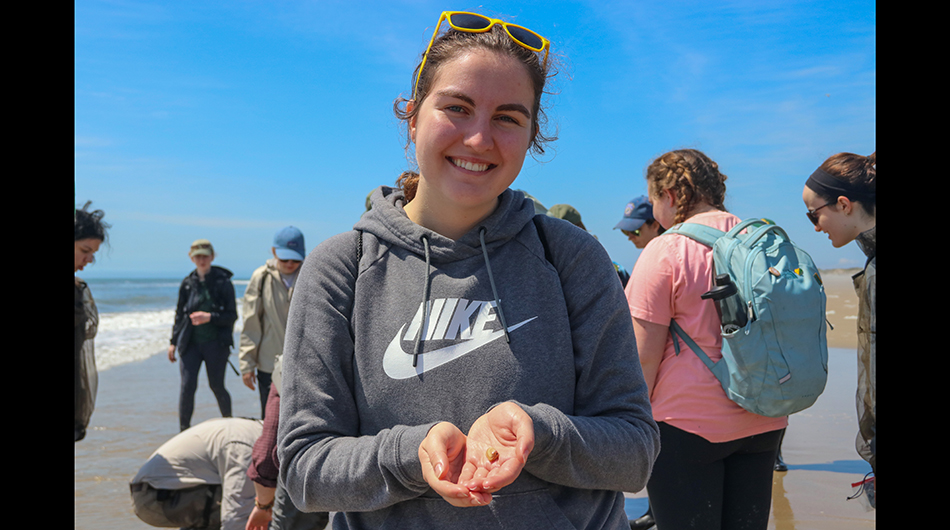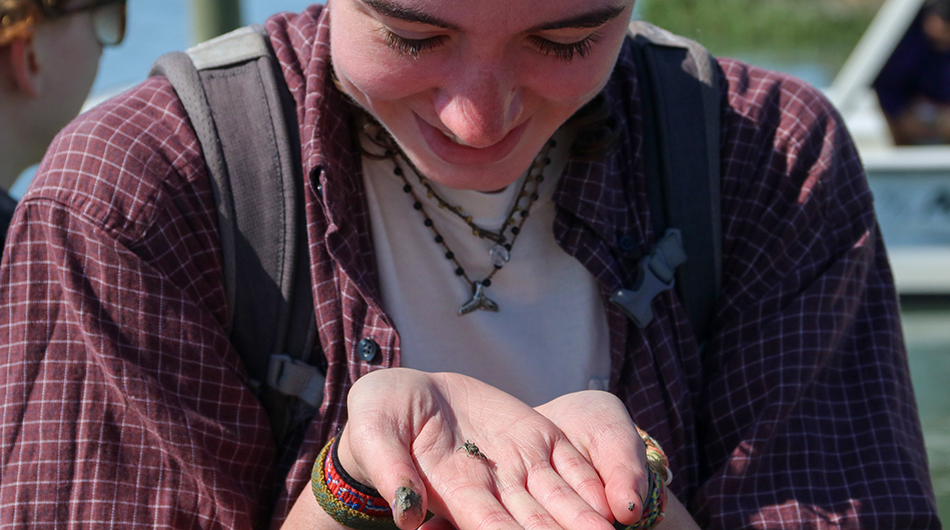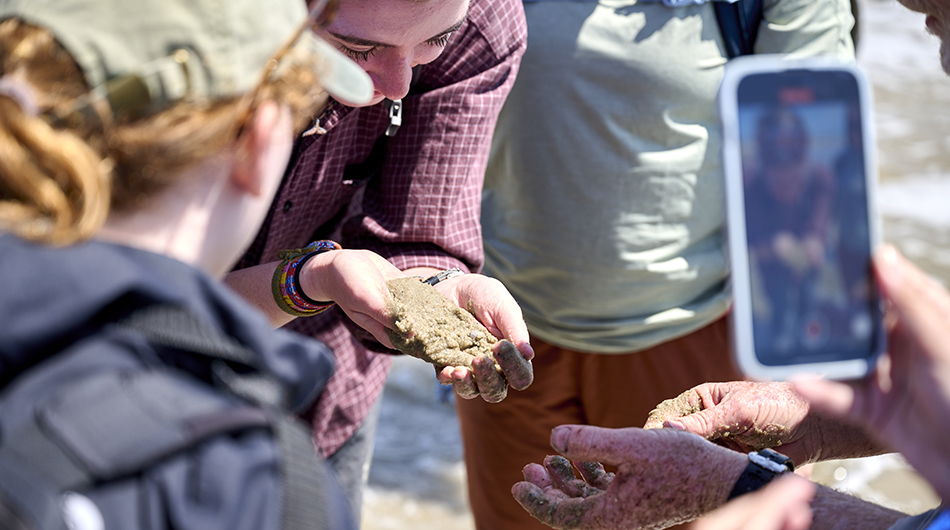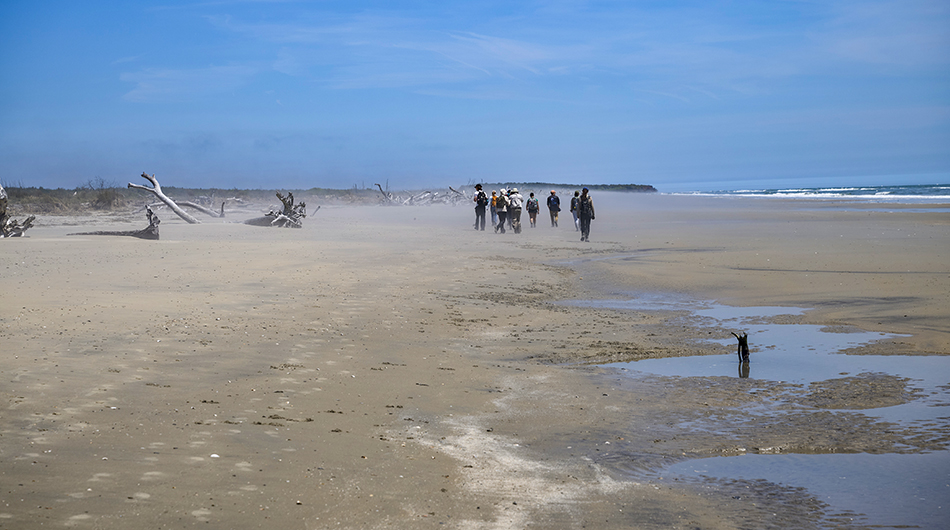The science and beauty of the Eastern Shore Laboratory undergraduate field course
The roughly four-mile, out-and-back hike on uninhabited Parramore Island on Virginia’s Eastern Shore took participants from a muddy marsh environment through a maritime forest, interior lagoon and finally over sand dunes to the shore of the Atlantic Ocean. Through it all, course instructors Dick Snyder and Stacy Krueger-Hadfield imparted their extensive ecological knowledge to 14 William & Mary undergraduate students.
The students were on the third day of a two-week course designed to expose them to field-based, coastal marine research. MSCI 331 Coastal Marine Environments is based out of William & Mary’s Virginia Institute of Marine Science (VIMS) Eastern Shore Laboratory (ESL), and it is consistently one of the most popular marine science undergraduate courses available at W&M due to the immersive, natural experience.
“A lot of places are running away from experiential learning, and that’s a shocking trend,” said Snyder, who has been director of the ESL for nearly a decade. “So, we really want to buck that trend and immerse these students in an experience that will engrain the knowledge more than sitting in a classroom.”
Krueger-Hadfield agrees. She recently joined VIMS and W&M's Batten School of Coastal & Marine Sciences as an associate professor and assistant director of the ESL, bringing with her unique knowledge of the algae that helps shape the coastal and marine ecosystems.
“Having the opportunity in a course where you can do a project, collect data, see the pitfalls with data collection, get up and present that project and get critiqued, it's not something that a lot of undergraduate students get to experience,” said Krueger-Hadfield. “That really prepares them for the future, especially if they decide to go to graduate school. They’re not doing it the first time when it's their master's thesis or a chapter from their dissertation.”
Fostering independent, experiential learning
The students arrived on Sunday, May 19. The first day was mostly business: Learning room assignments in the dorm, touring the campus, safety orientation, a course overview and the first evening lecture.
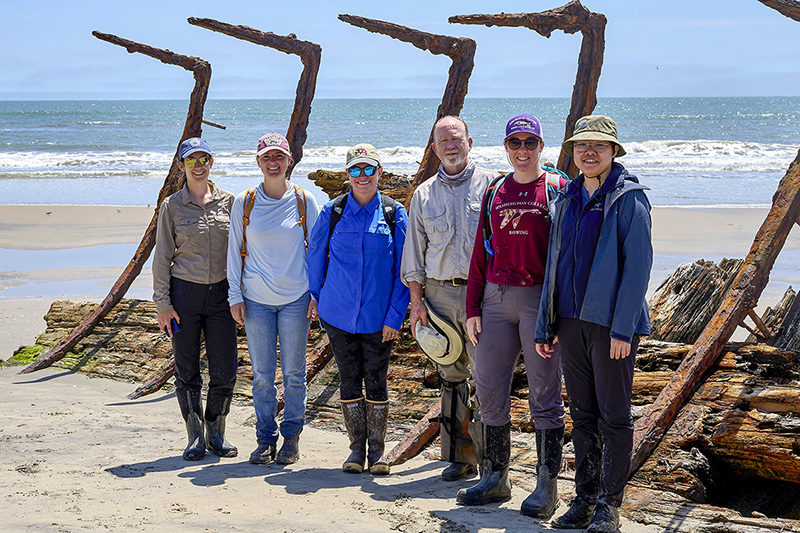 Emma Dodsworth served as one of two teaching assistants for the course, living in the dorm with the students and providing mentorship out in the field. With an undergraduate major in environmental science and now focusing on computer models of living shorelines while earning her M.S. in Marine Science at the Batten School, she saw the opportunity as a way to engage the students with what makes her so passionate about coastal ecology.
Emma Dodsworth served as one of two teaching assistants for the course, living in the dorm with the students and providing mentorship out in the field. With an undergraduate major in environmental science and now focusing on computer models of living shorelines while earning her M.S. in Marine Science at the Batten School, she saw the opportunity as a way to engage the students with what makes her so passionate about coastal ecology.
“Getting to be a part of their hands-on learning was what I really wanted to do, because those were the people that shaped my undergraduate experience,” said Dodsworth. “You don’t get your hands dirty sitting in a classroom. Out here, you get to see how all that stuff applies to the real world.”
Much of the first week was spent in the field learning about the coastal system of islands, marshes, reefs, creeks and bays. After a morning lecture, students and instructors boarded boats and weaved their way through the channels of marsh grasses exposed by the receding tide. They visited Cedar Island and Parramore Island, as well as other salt marshes surrounding the ESL, immersing themselves in all aspects of the nature around them. After returning and eating as a group, they attended an evening lecture. The course incorporated three guest instructors who lectured and educated students out in the field. The second week put the students in charge, as they pursued their independent research under the guidance of the instructors.
The main project for the course was to build a carbon budget for a mudflat ecosystem, such as those present throughout the Eastern Shore and its barrier islands. A carbon budget accounts for carbon emissions and carbon sinks within a system. To accomplish this, the students split into groups focusing on different ecological components that they would later pull together to create the carbon budget.
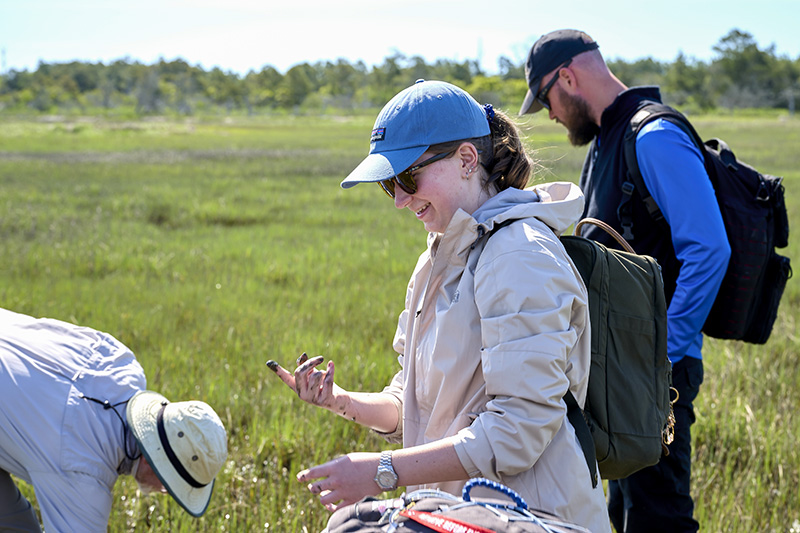 “There was a list of possible topics to choose from. There was a phytoplankton group, a fish group and some focused on mud snails. I chose benthic infauna, so I did a lot of digging for worms and little critters,” said Lexi Dyer, a rising sophomore at W&M. “There was something very awe inspiring about the entire thing. Going somewhere like Cedar Island and knowing you’re one of a relatively small group of people who have seen the whelks, horseshoe crabs and all of the other organisms was very cool to me."
“There was a list of possible topics to choose from. There was a phytoplankton group, a fish group and some focused on mud snails. I chose benthic infauna, so I did a lot of digging for worms and little critters,” said Lexi Dyer, a rising sophomore at W&M. “There was something very awe inspiring about the entire thing. Going somewhere like Cedar Island and knowing you’re one of a relatively small group of people who have seen the whelks, horseshoe crabs and all of the other organisms was very cool to me."
Dyer plans to major in biology and minor in marine science, though she hopes to change her major to marine science if a planned undergraduate degree program is approved and becomes available in 2025 through the Batten School. Not only interested in science, Dyer also enjoys art. During the course, she painted several watercolor paintings that are now on display at the ESL. She also made connections with the other students that have lasted beyond the course.
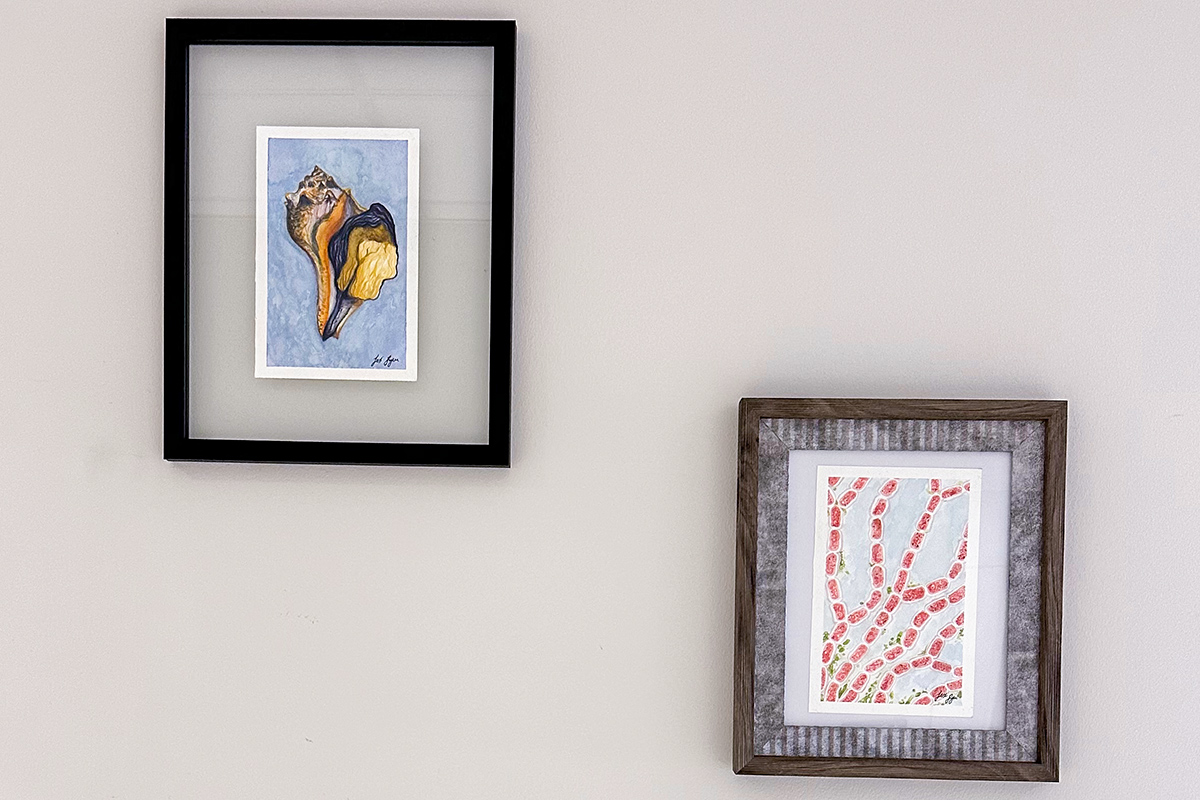
“The community aspect was really amazing and something that I was not expecting. You’re not just taking a class with other students, you’re living with them for two weeks. You get to see what parts that they love and what organisms they gravitate toward—that was one of my favorite parts of the experience,” said Dyer.
The evolution of the ESL and the course
The ESL was established in 1960 as a research outpost to monitor the spread of oyster pathogens and pursue aquaculture research. VIMS hired Michael Castagna as the Lab’s first director in 1962, and he and his small staff performed much of the work required to build the original laboratory. These people were responsible for the research and development that started Virginia’s hard clam aquaculture industry, now providing the number one seafood product by value for the entire commonwealth.
Following Castagna’s retirement in 1992, Mark Luckenbach, now associate dean of research and advisory service at VIMS, assumed the director role. In that decade, the ESL was expanded as a general-purpose field station to support research and education, and significant construction and renovation ensued. The undergraduate field course was established in 1999, though the site already supported educational activities not only for W&M and VIMS but also for partner institutions and the public.
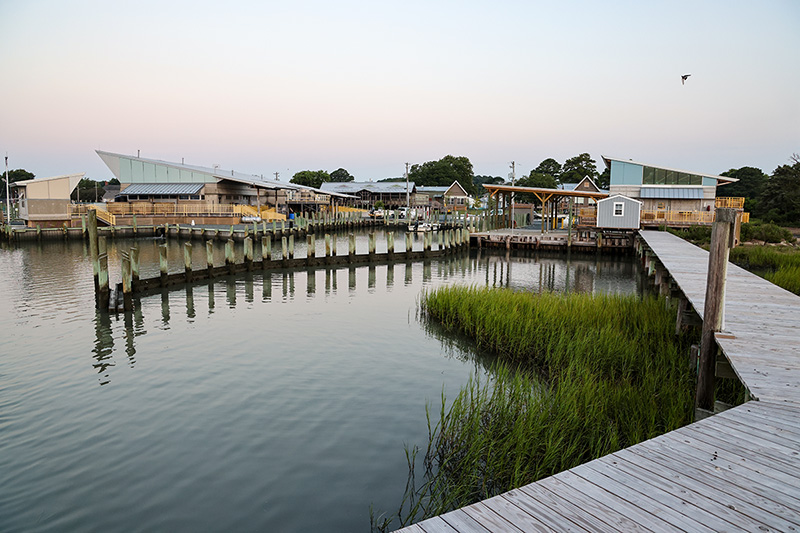 The ESL has undergone many changes since the course began. In 2012, a large renovation brought a new Seawater Laboratory, the Castagna Shellfish Research Hatchery and Seaside Hall, significantly expanding research, education and aquaculture efforts throughout the campus. In 2022, additional construction brought a new dormitory, administrative building, maintenance and fabrication shop and additional teaching and laboratory facilities.
The ESL has undergone many changes since the course began. In 2012, a large renovation brought a new Seawater Laboratory, the Castagna Shellfish Research Hatchery and Seaside Hall, significantly expanding research, education and aquaculture efforts throughout the campus. In 2022, additional construction brought a new dormitory, administrative building, maintenance and fabrication shop and additional teaching and laboratory facilities.
“Some of the biggest improvements to the course have resulted from the construction of new facilities,” said Snyder. “We’ve added a lot of equipment, labs and teaching spaces. Not only do the students get totally immersed in the field, but we continually enhance the quality of the science that’s being performed through high-quality facilities and equipment available to the students.”
Now, the ESL looks to a future that supports an undergraduate major in marine science.
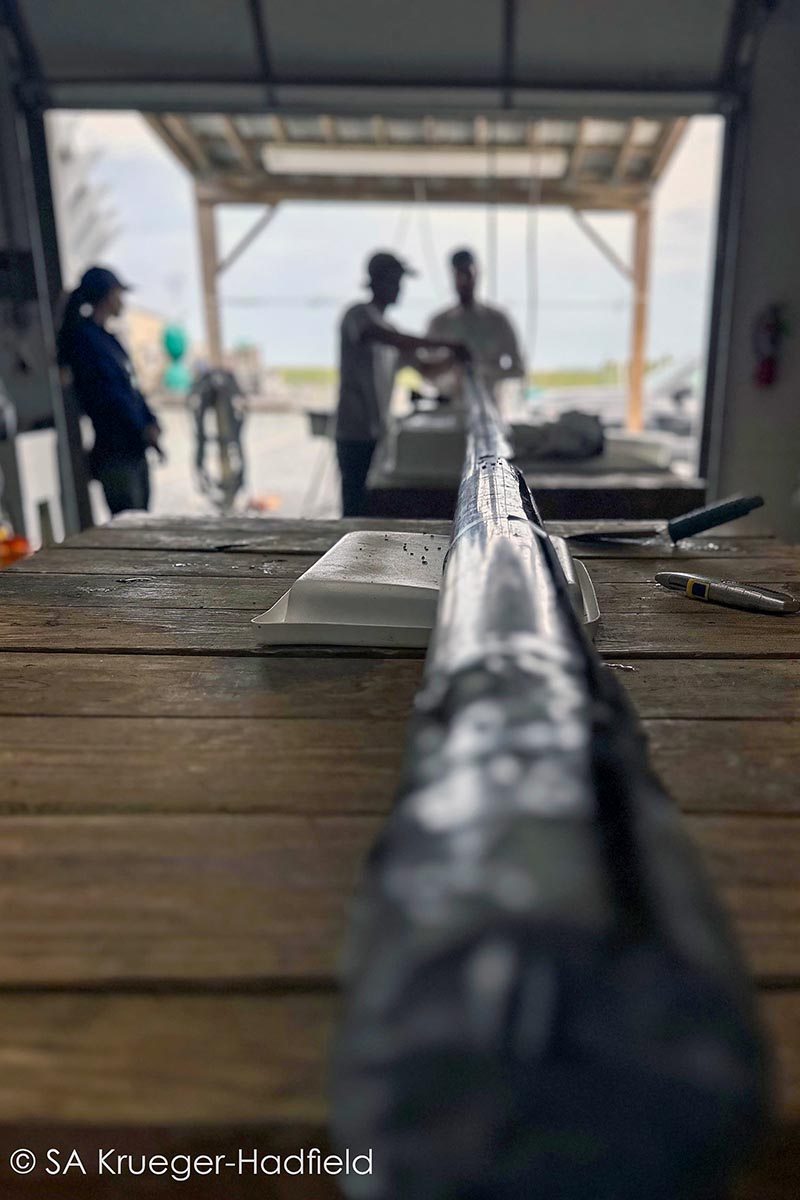
One of the three guest instructors during the course was Christopher Hein, an associate professor at the Batten School and VIMS. Not only is Hein a coastal geologist who showed the students how to take a 20’ core sample using his large vibracoring rig, he is also director of undergraduate programs at VIMS. He says that there has been renewed and growing interest in marine science at W&M.
“If you look at past evaluations, this course is consistently ranked as one of, if not our top class in the minor program because of the way it’s taught and the environment in which it takes place,” said Hein. “Apart from the natural beauty, I think what makes this class so special is that it’s not the same every year. The learning objectives are focused on hands-on experience and bringing together multiple fields of study, but that can be accomplished in different ways. The students get to see things each year through unique lenses brought by the instructors’ expertise.”
Participation in a field course is currently a requirement for students pursuing a minor in marine science at W&M. In addition to MSCI 331, students can also choose to take MSCI 332, Coastal Environments in North Wales: Geology, Ecology, and Human Dimensions, which is offered every two years and is also very popular.
As plans for the marine science major move forward, additional opportunities for field study will be offered to accommodate the increased number of students in the program. While there will still be a field requirement for the major and minor, it will no longer be limited to MSCI 331 and 332, and there are plans to include a field and research methods course taught on VIMS' Gloucester Point campus during fall semesters.
“Such a new class will increase access to field-based education and satisfy our desire for students to gain hands-on experience. But it will in no way be a ‘replacement’ for the ESL class, because you simply cannot find a better setting than the Eastern Shore for studying coastal marine science,” said Hein.
This year, Krueger-Hadfield stepped up as lead instructor for MSCI 331, bringing new ideas and expertise to enhance the course. Having already introduced a macroalgal (seaweed) component, she is thinking ahead to adaptations coinciding with the introduction of the major.
“We need to think pragmatically about what the course looks like if the major becomes available and there are other courses that the students can take to satisfy field requirements,” said Krueger-Hadfield. “Keeping the ethos of the course is important, but we will monitor enrollment and consider fresh ideas to keep this an attractive offering for students.”
For many, that attractiveness comes with the setting.
“The Eastern Shore Lab, in my opinion, is one of the most special things about VIMS,” said Hein. “I’ve done most of my research there, living and working out of the lab. I love that the undergraduates get the opportunity to experience all the things that I feel make the lab and the Eastern Shore so special.”
VIMS would like to acknowledge and thank the Nature Conservancy for our partnership that allows us to utilize the barrier islands in the Volgenau Virginia Coast Reserve for educational and research purposes.


